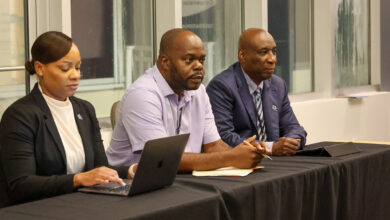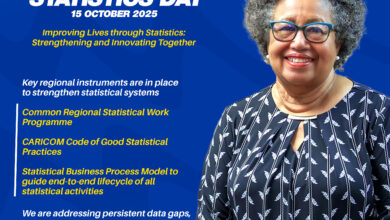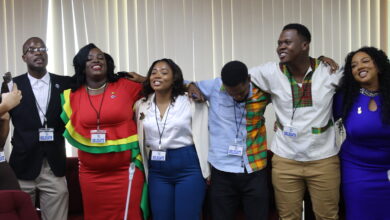Honourable Sheik Baksh, Minister of Education of Guyana and Chairman of the Council for Human and Social Development (COHSOD);
Ministers of Government of CARICOM Member States; Professor Nigel Harris, Vice Chancellor, University of the West Indies; Professor Lawrence Carrington, Vice Chancellor, University of Guyana; Members of the Diplomatic Corps; Dr. Edward Greene, Assistant Secretary-General, Human and Social Development and other staff of the Secretariat; Government Officials Mr. Stephen Roberts, Youth Representative Specially Invited Guests; Representatives of the Media; Ladies and Gentlemen;
(CARICOM Secretariat, Turkeyen, Greater Georgetown, Guyana) – It is my pleasure to be present today at this Twentieth Meeting of the Council for Human and Social Development (COHSOD). It provides me as Secretary-General with the opportunity of joining the previous speakers in welcoming you all most warmly and, at the same time, thanking you most sincerely for your very kind and inspirational words and for the generosity of spirit that so many of you have displayed to me personally, and to the Secretariat, more generally.
I am particularly heartened by the perspectives of Mr. Stephen Roberts, the youth representative for his insightful and measured recommendations for making our education system more relevant and meaningful. His thoughts will no doubt resonate throughout the deliberations at this Meeting and become an essential aspect of its conclusions.
So too, I believe, should the philosophy of the Indian Nobel Prize Winner, Amartya Sen. His view of development and education is substantially different from the Western market-oriented focus, more a focus on the human aspects of development, somewhat similar in some respects to that of William Demas. Sen defines development through the freedom and opportunities people have and the role of education as enabling them to live the lives they want and to increase their choices. In summary, Sen identifies the investment in human resources with “human empowerment and increased capabilities through access to basic education and knowledge”
Relevance of the Theme Investing in Human Resources
It is against that background that the theme for this Twentieth COHSOD, Investing in Human Resources for the benefit of all is particularly fitting, especially at this time. However, before dealing with the reasons for this observation it is important to determine what we mean by Human Resources, even if to some, it is self evident.
Ministers, Delegates, Ladies and Gentlemen, an authoritative glossary defines human resources “as the people that staff and operate an organization as distinct from financial and material resources.” Extrapolating from this definition for the purpose of this COHSOD, I consider Human Resources to be more generally, the vast pool of people – children, adolescents, young and old, on which a country and Region can draw for the development of its natural and creative products by harnessing their individual and collective skills and talents.
The issues on which this COHSOD focuses – higher education coordination, accreditation, gender and education, ICT and education and the special links between youth education and employment – are all essential aspects of human resources development.
Issues and Indicators of Human Resources Development
History shows that during an economic crisis, and we are just about exiting from one, there is a tendency for investments in education and other aspects of human resource development to decline. Yet, it has been equally demonstrated that during such crises, it is vital to strengthen support to education and the other social sectors in order to bolster the economic recovery process. There tends to be less when we need to do more. Returns on investment in education based on human capital theory have been estimated since the late 1950s. Human capital theory puts forward the concept that investments in education increase future productivity. There have been thousands of estimates, from a wide variety of countries; some based on studies done over time and some based on new econometric techniques. All reaffirm the importance of investing in human resources.
The concept of the rate of return on investment in education is very similar to that for any other investment. It is a summary of the costs and benefits of the investment incurred at different points in time. It is expressed in an annual (percentage) yield, similar to that quoted for savings accounts or the budgets presented by governments or the balance sheet that private sector organizations present to their shareholders.
Many of the terms used to describe the economy today no longer reflect reality. Everybody knows for example, that the lights would go out, the airplanes would stop flying, and the banks and many of the factories would shut down if the computer software that runs their systems suddenly vanished. Yet these software – crucial 'intellectual' assets if you care, do not appear in any substantial way on the world's balance-sheets. Instead, the balance sheets are full of 'tangible' assets — buildings and machinery, stocks and financial reserves.
I am sure that the panel on higher education that follows this Opening Session led by the Vice Chancellors of the University of the West Indies (UWI) and the University of Guyana (UG) will help both the governments and the private sector to reflect on how they actually measure capital formation, when much new capital is intellectual? How do they gauge the productivity of the knowledge of workers whose products cannot be counted? And how then can they track productivity growth? How, then, to ensure that the costs and benefits of further education and training in these circumstances are properly measured? How in other words to properly make the case for investing in Human resources for the benefit of all?
Connecting the dots in the Human Resource Agenda
Ladies and Gentlemen, judging from the Agenda of this Meeting, I have no doubt that this COHSOD will address those critical indicators of human resource development that help us to justify the investments in education in particular as a vital mechanism for increasing the viability of the labour market and its competitive edge in the global arena. In this regard, there are Regional standard bearers and outstanding role models on the international stage : Sir Arthur Lewis, Derek Walcott, Vidia Niapaul, Nobel Prize Laureates from this Region, Bob Marley, our musical icon, Sir Garfield Sobers, the greatest cricketer and of course the latest sensation, Usain Bolt .
The question is how do we convert this manifestation of excellence in various academic and sporting fields into a sense of pride in the Region that is sustainable and that is wider than the notion of returns to investment in human capital. I believe that the answer resides in: harnessing the potential for regional collaboration; strengthening the regional institutions and promoting the cultural industries as collaborative ventures. In this way, we can promote the cross fertilization of cultures through events like CARIFESTA that connect the people. In other words we connect the dots through “people-to-people contact”, through joint responses to emergencies, through fostering greater exchange of information and debate on regional matters. What is often referred to as creating the enabling environment to achieve these goals is dependent on the good will of our political leaders, the private sector and the civil society and academia. Only by taking these steps I believe, can we really make our investment in human resources benefit all.
As the Assistant Secretary-General for Human and Social Development has pointed out in his Opening Remarks, the records of COHSOD are replete with illustrations of the importance of Functional Cooperation in Education. The existence of UWI since 1948 and the Caribbean Examination Council (CXC) since 1973 are outstanding examples. I have no doubt that the focus of this Meeting on the use of ICT in the enhancement of the educational products is of vital importance. This is particularly the case as we strive to fully determine the role of the Caribbean Knowledge and Learning Network (CKLN) and the distance education techniques in uniformly expanding the range of opportunities for accessing education and training and continuous learning.
I am also quite sure that in this regard, this Meeting will help us to understand the necessity of research and development that produced for example, the G-pan, a highly acclaimed innovation that has taken the scope of the steel pan to a new level of perfection. This achievement is associated with a group of scientists from UWI led by Professor Copeland who I acknowledge is in our presence today. Efforts like these illustrate the elevated role that our scientists can play in advancing the international standing of CARICOM in the World while connecting us with the so called little people. It was ordinary boys and men from the inner cities of Trinidad and Tobago, the real geniuses in a way, whose amazing talents– as they sat liming under trees in the early 1940s in Port-of-Spain – who were responsible for the invention of the steel pan, which turned out to be the only musical invention since the end of the 19th century. What an amazing feat!
Simultaneously, I believe that one “dot” that this COHSOD must connect is Haiti. The question is what contribution will COHSOD resolve to make in the reconstruction of Haiti? And how; and when?
This takes me to what I believe to be the “tipping point” of your discussions at this Twentieth COHSOD: the economic and social justification for increased investment in human resources, with special reference to the marginalized youth in our Community.
Economic and Social Rationale for Increased Investment: The Special Case of Marginalized Youth
If the investment in human resources is to benefit all, then the marginalized youth is a specific group that requires special attention.
The United States Agency for International Development (USAID), the World Bank, the International Labour Organisation (ILO) and other development agencies are beginning to recognize the need to assist governments in reassessing their spending priorities by demonstrating concrete economic evidence that this youth cohort is indeed a priority for funding. The World Bank, for example, devoted the 2007 World Development Report to addressing the importance of investing in youth. The Report of the Caribbean Commission on Youth Development provided some evidence-based data and made concrete policy suggestions that have been included in the Paramaribo Declaration of January 2010. The Remarks by Mr. Stephen Roberts point in this direction also. Yet, there is need for more rigorous analysis of the costs and benefits of programs and policies for out of school and unemployed youth. From both the World Bank and the Caribbean Commissions Reports some valuable consequences of not investing in out of school youth include:
• Unmet development goals such as Education for All
• Underdeveloped and underutilized human and social capital
• Loss of economic productivity
• Increased unemployment and underemployment
• Increased violence, crime, and risky behaviors
• Exploitation and marginalization of youth, especially girls and young women
• Reduced social cohesion and disruption in civil society
• Increased spending on remedial social welfare services and crime prevention
Addressing Youth needs is key to meeting the UN Millennium Development Goals (MDG) which was the main focus of attention at the UN Special Session held in New York two weeks ago. Of great relevance to what I am getting at for example, is that the MDGs seek by 2015 to eradicate extreme poverty and hunger, achieve universal primary education, promote gender equality, empower women, reduce child mortality, improve maternal health, combat HIV/AIDS, malaria and other diseases, and ensure environmental sustainability.
Out-of-school and unemployed youth must be a major constituency for programs to achieve all of these goals. This accords with the macro view of Amartya Sen when he identified the investment in human resources with “human empowerment and increased capabilities through access to basic education and knowledge.”
Parting Words
Mr. Chairman, let me therefore end by commending the COHSOD for initiating and implementing some of the most innovative programmes and also to congratulate the Directorate of Human and Social Development for its coordinating role. This has been especially evident in the areas of early childhood education, health and family life education, crime prevention and youth development, facilitating peer group counseling throughout the CARICOM Region in the prevention of HIV/AIDS among youth, led by the CARICOM Youth Ambassadors and financed by PANCAP. Let me also commend you for the follow-up to the Paramaribo Declaration which includes a public goods proposal to the Inter-American Development Bank focusing on policies to stimulate entrepreneurship and employability among the youth of the Caribbean. All these fully illustrate the true meaning of investing in human resources.
But what needs to be highlighted and promoted is the role that members of the Directorate of Human and Social Development have played in taking these programmes and the face of the Community to the inner cities of Tivoli Gardens in Jamaica, Albouystown in Guyana and Laventille in Trinidad and Tobago. They must also be congratulated for using the creative methods of street theatre and edutainment to bring the messages to the attention of all. Indeed, the exhibition of posters and material associated with this COHSOD speaks volumes to the role that the Caribbean Community Secretariat in support of the Council of Human and Social Development and our development Partners are playing in building a Community for ALL.
This, Mr. Chairman, Ladies and Gentlemen, is the last COHSOD in which I will be involved as Secretary-General. I leave the scene confident that especially in this area of human and social development, CARICOM has truly made a difference. Yet there is much more to be done. Let it be done!





